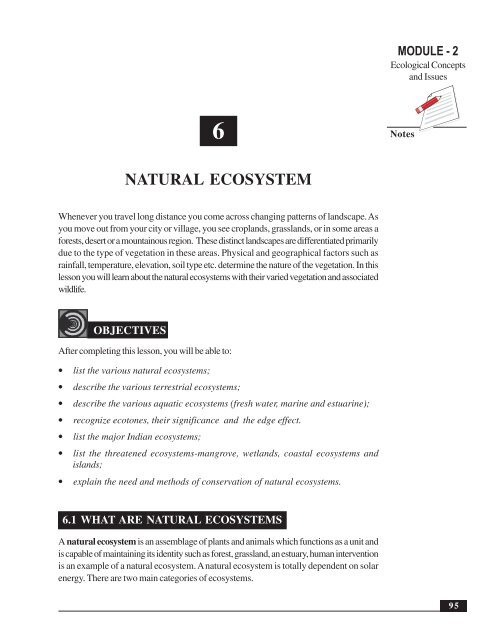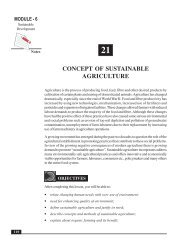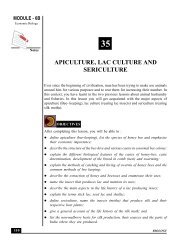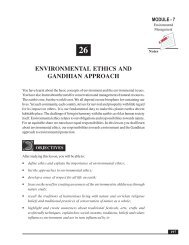Natural Ecosystem
Natural Ecosystem
Natural Ecosystem
Create successful ePaper yourself
Turn your PDF publications into a flip-book with our unique Google optimized e-Paper software.
<strong>Natural</strong> <strong>Ecosystem</strong>MODULE - 2Ecological Conceptsand Issues6NotesNATURAL ECOSYSTEMWhenever you travel long distance you come across changing patterns of landscape. Asyou move out from your city or village, you see croplands, grasslands, or in some areas aforests, desert or a mountainous region. These distinct landscapes are differentiated primarilydue to the type of vegetation in these areas. Physical and geographical factors such asrainfall, temperature, elevation, soil type etc. determine the nature of the vegetation. In thislesson you will learn about the natural ecosystems with their varied vegetation and associatedwildlife.OBJECTIVESAfter completing this lesson, you will be able to:• list the various natural ecosystems;• describe the various terrestrial ecosystems;• describe the various aquatic ecosystems (fresh water, marine and estuarine);• recognize ecotones, their significance and the edge effect.• list the major Indian ecosystems;• list the threatened ecosystems-mangrove, wetlands, coastal ecosystems andislands;• explain the need and methods of conservation of natural ecosystems.6.1 WHAT ARE NATURAL ECOSYSTEMSA natural ecosystem is an assemblage of plants and animals which functions as a unit andis capable of maintaining its identity such as forest, grassland, an estuary, human interventionis an example of a natural ecosystem. A natural ecosystem is totally dependent on solarenergy. There are two main categories of ecosystems.95
MODULE - 2Ecological Conceptsand IssuesNotesEnvironmental Science Senior Secondary Course(1) Terrestrial ecosystem: <strong>Ecosystem</strong>s found on land e.g. forest, grasslands, deserts,tundra.(2) Aquatic ecosystem: Plants and animal community found in water bodies. These canbe further classified into two sub groups.(i) Fresh water ecosystems, such as rivers, lakes and ponds.(ii) Marine ecosystems, such as oceans, estuary.INTEXT QUESTIONS 6.11. What is a natural ecosystem?______________________________________________________________2. Which are the main categories of natural ecosystems?______________________________________________________________3. Give examples of terrestrial ecosystems.______________________________________________________________4. Give examples of fresh water ecosystems.______________________________________________________________6.2 TERRESTRIAL ECOSYSTEMSTerrestrial ecosystems are (a) forests (b) grasslands, (c) deserts and (d) tundra(a) ForestsForests are large areas supporting rich growth of trees. Depending on the climate and typeof trees they are generally grouped into:(i) Tropical rain forests(ii) Temperate deciduous forests(iii) Boreal or north coniferous forests(i) Tropical rain forest• Distribution: These are found in the high rain fall areas on either side of the equator.Such forests are found in the western coast of India, scattered in south east Asia, someparts of Africa and south America.• Flora and fauna: Tropical rainforests occur in areas by having high temperature andhigh humidity and receives above 200 cm of rainfall per year. Soil is rich in humus.96
<strong>Natural</strong> <strong>Ecosystem</strong>These forests have a very rich biodiversity e.g. Brazilian tropical rain forests havemore than 300 species of trees in an area of 200 square kilometer. Trees are tallgrowing upto 50 to 60 m. These forests also support epiphytes, like vines, creepers,woody creepers and orchid etc. These forests are rich in tree dwelling animals such asmonkeys, flying squirrels, snails, centipedes, millipedes, and many insect species arecommon on the forest floor.(ii) Temperate deciduous forestsMODULE - 2Ecological Conceptsand IssuesNotes• Distribution: They occur mostly in northwest, central and eastern Europe, easternnorth America, north China, Korea, Japan, far eastern Russia and Australia. Trees ofdeciduous forests shed their leaves in autumn and a new foliage grows in spring.• Climate: These forests occur in the areas of moderate climatic conditions such astemperature ranging but 10 to 20 o C with a 6 month long winter and an annual rainfallbetween 75 to 150 cm. They have its brown soils which are rich in nutrients.• Flora and fauna: Common trees are oak, beach, heath, chest nut, birch, pine. Theseforests also show stratification and have a under storey of saplings shrubs and tallherbs. Prominent grazers include deer, bison and rodents. Rodents play a very importantrole in these forests. They feed on seeds, fruits and tree leaves. Black bear, raccoons,wild cat, wolves, fox and skunks are the omnivores found in these forests. Hibernationor winter sleep during winter is a common feature of animals found in these forests.Invertebrate fauna comprises green flies, aphids, certain moths and butterflies.(iii) Boreal or north coniferous forests:• Distribution: Coniferous forests are also known as ‘Taiga’. They extend as a continuousbelt across north America and north Eurasia below the arctic tundra. There is nocounterpart of these forests in southern hemisphere as there is no land at this latitude.Climate is cold with long, harsh winter, with mean annual temperature below 0 0 C. Thesoils are acidic and poor in nutrients.• Flora and fauna: Coniferous forests are characterized by evergreen, drought resistantand woody. Conifers (gymnosprerms) e.g. spruce, fir and pine trees which bear nakedseeds in cones. The animals found in these forests, are red squirrel, deer, goat, mule,moose etc. The carnivores which feed upon them are timber wolves, lynxes, bear.Some common birds are crossbill, thrushes, warblers, flycatchers, robin and sparrow.(b) Grasslands• Distribution: Grasslands are areas dominated by grasses. They occupy about 20%of the land on the earth surface. Grasslands occur in both in tropical and temperateregions where rainfall is not enough to support the growth of trees. Grasslands areknown by various names in different parts of the world.97
MODULE - 2Ecological Conceptsand IssuesNotesEnvironmental Science Senior Secondary CoursePlaceName of the grasslandNorth AmericaPrairiesEurasia (Europe and Asia)SteppesAfricaSavannaSouth AmericaPampasIndiaGrassland, SavannaGrasslands are found in areas having well defined hot and dry, warm and rainy seasons.Tropical grasslands are commonly called Savannas. They occur in eastern Africa, SouthAmerica, Australia and India. Savannas form a complex ecosystem with scattered mediumsize trees in grass lands.• Flora and fauna: Grasses are the dominating plants with scattered drought resistantthorny trees in the tropical grasslands. Badgers, fox, ass, zebra, antelope are foundgrazing on grasslands support the dairy and leather industries. Grasslands also supportlarge population of rodents, reptiles and insects.(c) Deserts• Distribution: Deserts are hot and low rain areas suffering from water shortage andhigh wind velocity. They show extremes of temperature. Globally deserts occupy about1/7 th of the earth’s surface.• Flora and fauna: Cacti, Acacia, Euphorbia and prickly pears are some of thecommon desert plants. Desert animals include shrew, fox, wood rats, rabbits, camelsand goat are common mammals in desert. Other prominent desert animals are, reptiles,and burrowing rodents insects.• Adaptations: Desert plants are hot and dry conditions.(i) These plants conserve water by following methods:• They are mostly shrubs.• Leaves absent or reduced in size.• Leaves and stem are succulent and water storing.• In some plants even the stem contains chlorophyll for photosynthesis.• Root system well developed spread over large area.(ii) The animals are physiologically and behaviorally adapted to desert conditions.• They are fast runners.• They are nocturnal in habit to avoid the sun’s heat during day time.98
<strong>Natural</strong> <strong>Ecosystem</strong>• They conserve water by excreting concentrated urine.• Animals and birds usually have long legs to keep the body away from the hotground.• Lizards are mostly insectivorous and can live without drinking water for severaldays.• Herbivorous animals get sufficient water from the seeds which they eat.Camel is known as the ship of the desert as it can travel long distances without drinkingwater for several days.MODULE - 2Ecological Conceptsand IssuesNotes(d) TundraThe word tundra means a “barren land” since they are found in those regions of the worldwhere environmental conditions are very severe. There are two types of tundra- arcticand alpine.• Distribution: Arctic tundra extends as a continuous belt below the polar ice capand above the tree line in the northern hemisphere. It occupies the northern fringe ofCanada, Alaska, European Russia, Siberia and island group of arctic ocean. On thesouth pole Anatarctica tundra in the south pole is very small since most of it iscovered by ocean .Alpine tundra occurs at high mountains above the tree line. Since mountains arefound at all latitudes therefore alpine tundra shows day and night temperature variations.• Flora and fauna: Typical vegetation of arctic tundra is cotton grass, sedges, dwarfheath, willows, birches and lichens. Animals of tundra are reindeer, musk ox, arctichare, caribous, lemmings and squirrel.Most of them have long life e.g. Salix arctica that is arctic willow has a life span of 150 to300 years. They are protected from chill by the presence of thick cuticle and epidermalhair. Mammals of the tundra region have large body size and small tail and ear to avoid theloss of heat from the surface. The body is covered with fur for insulation. Insects haveshort life cycles which are completed during favourable period of the year.INTEXT QUESTIONS 6.21. What are deciduous trees?______________________________________________________________2. Explain two common characteristics of the desert.______________________________________________________________99
MODULE - 2Ecological Conceptsand IssuesNotesEnvironmental Science Senior Secondary Course3. How are the animals and plants of deserts adapted to heat and drought?______________________________________________________________4. Where are Prairies and Steppes are found?______________________________________________________________6.3 AQUATIC ECOSYSTEMSAquatic ecosystems refers to plant and animal communities ocuring in water bodies. Aquaticecosystems are classified on the basis of salinity into following two types:(i) Freshwater(ii) Marine(i) Fresh water ecosystemWater on land which is continuously cycling and has low salt content is known as freshwater and its study is called limnology.(i) Static or still water (Lentic) e.g. pond, lake, bogs and swamps.(ii) Running water (Lotic) e.g. springs, mountain brooks, streams and rivers.Physical characteristics: Fresh waters have a low concentration of dissolved salts.The temperature shows diurnal and seasonal variations. In tropical lakes, surface temperaturenever goes below 40 0 C, in temperate fresh waters, never goes above or below 4 0 C and inpolar lakes never above 4 0 C.• In temperate regions, the surface layer of water freezes but the organisms survivebelow the frozen surface.• Light has a great influence on fresh water ecosystems. A large number of suspendedmaterials obstruct penetration of light in water.• Certain animals float upto water surface to take up oxygen for respiration Aquaticplants use carbon dioxide dissolved in water for photosynthesis.• Lakes and ponds are inland depressions containing standing water. The largest lake inthe world is lake Superior in North America. Lake Baikal in Siberia is the deepest.Chilka lake of Orissa is largest lake in India.Three main zones can be differentiated in a lake:-• Peripheral zone (littoral zone) with shallow water.• Open water beyond the littoral zone where water is quite deep.• Bentic zone (bottom) or the floor of the lake.100
<strong>Natural</strong> <strong>Ecosystem</strong>Aquatic organisms can be floating in water or free swimming or sedentary (fixed), dependingon their size and habit. Microscopic floating organisms such as algae, diatoms, protozoansand larval forms are called plankton. Rooted aquatic plants, fish, mollusk and echinodermsare bottom dwellers. (Recall from lesson-5, Fig. 5.1)Wetlands are areas that periodically get inundated with water and support a flourishingcommunity of aquatic organisms including frog and other amphibians. Swamps, marshesand mangroves are examples of wetlands.MODULE - 2Ecological Conceptsand IssuesNotes(ii) Marine ecosystem: Pertains to the seas and oceans including marine organisms.• Distribution: Marine ecosystem covers nearly 71% of the earth’s surface with anaverage depth of about 4000 m. Fresh water rivers eventually empty into ocean. Differentkinds of organisms live at different depths of the sea or ocean.Salinity of open sea is 3.6% and is quite constant.The range of temperature variation is much less in the sea than on the land. Hydrostaticpressure due to water column increases with depth in oceans. It is1 atm near the surface and 1000 atm at greatest depth. Animals in the deeper layers areadapted to the high pressure. Some marine organisms such as sperm whales and certainseals can dive to the great depths and swim back to the surface without difficulty. Tides,due to gravitational pull of the moon are a common feature of marine ecosystems.• Flora and fauna: Biodiversity of the marine ecosystems is very high as compared toterrestrial ecosystems. Almost every major group of animals occurs in the sea. Insects andvascular plant are completely absent in marine ecosystem. Maximum diversity of marineorganisms is found in the tidal zone that is near the shore. Diatoms, algae, dinoflagellatesand jelly fishes are some of the free floating life forms in oceans. Large crustaceans, molluscs,turtles and mammals like seals, porpoises, dolphins and whales are free swimming animalsthat can navigate. Bottom dwellers are generally sessile (fixed) organisms like sponges,corals, crabs and starfish.• Adaptations:• Light weight animals and plants float in water and move with the water currents.• Animals and plants in ocean are tolerant to high concentration of salts (osmoregulation).Osmoregulation is the process by which a constant osmotic pressure is maintained inblood.• Swimming animals have streamlined body. Their body is laterally compressed.• Deep sea forms show bioluminescence (they emit light).• They are dependent for their food on the upper sea zones.101
MODULE - 2Ecological Conceptsand IssuesEnvironmental Science Senior Secondary CourseINTEXT QUESTIONS 6.3Notes1. What is plankton?______________________________________________________________2. What is aquatic ecosystem?______________________________________________________________3. Name two plants and two animals which found in marine ecosystem.______________________________________________________________6.4 ECOSYSTEMS OF INDIAIndia is a vast country and possess many types of natural ecosystems.(a) Terrestrial1. Forests(i) Tropical rain forests(ii) Tropical deciduous forests(iii) Temperate broad leaf forests(iv) Temperate needle – leaf or coniferous forests(v) Alpine and tundra forests2. Grasslands3. Deserts(i) Thar deserts(ii) Rann of Kutch4. Mountains — The Himalayas5. Ghats(b) Aquatic 1. Fresh water ecosystem2. Marine ecosystem6.4.1 Terrestrial ecosystem in IndiaForestsForests in India can be classified in different ways, according to their position, atmosphere,weather condition etc. Some of the common characteristics of various types of naturalvegetation in India includes:102
<strong>Natural</strong> <strong>Ecosystem</strong>• tropical rain forests,• tropical deciduous forests,• temperate broad leaf forests.• temperate needle leaf or coniferous forests• alpine and tundra forests, etc.Apart from these, there are also some other types of forests are found in India like tidalforests, Himalayan vegetation, rain forests of southern India, desert region, etc.MODULE - 2Ecological Conceptsand IssuesNotes(i) Tropical rain forestsThe tropical rain forests are playing an important role in natural vegetation in India. Thesetypes of forests include the tropical evergreen forests and tropical semi-evergreen forestsand they are mostly found in places where there is plenty of rainfall and sunshine throughoutthe year. Growth of the trees is usually at its best where rainfall is in surplus of 200 cm, witha short dry season. Such types of forests are found within rainy slopes of the WesternGhats, plains of West Bengal and Orissa and north-eastern India. Trees grow very brisklyin these forests and attain heights of about 60 m and above. The number of species in theseforests is too vast and too assorted to utilise each one of them commercially. Ebony,mahogany and rosewood are the main trees of these forests.(ii) Tropical deciduous forestsTropical deciduous forests are also known as deciduous (whether it is moist or dry)forestsbecause they cast leaves for about six to eight weeks in summer. They are also called themonsoon forests with all their grandeur and beauty. This is so because they form a naturalcover approximately all over India, especially within regions having 200 and 75 cm ofannual rainfall. Most of the tropical deciduous forests are found in the state of Kerala inIndia. Apart from Kerala, these forests can be found in the eastern slopes of WesternGhats and also in the north eastern parts of the peninsular plateau and in the valleys of theHimalayas. The tropical deciduous forests are pretty substantial, cost- effective and theydemand a lot of maintenance, as they are less resistant to fire. These forests can be dividedinto moist and dry deciduous forests. The moist deciduous forests are most commonlyfound on the eastern slopes of the Western Ghats. They are also found in the region ofChhotanagpur plateau, covering east Madhya Pradesh, south Bihar, and west Orissa,Shiwaliks in the northern India. Important trees of these forests are teak, sal, andsandalwood.(iii) Temperate broad leaf forestsIt mainly occur between 1500-2400 m altitudes in western Himalayas. Several species ofOak (Quercus) are found in these forests. Oak species are ever green in the Himalayan103
MODULE - 2Ecological Conceptsand IssuesNotesEnvironmental Science Senior Secondary Courseregion. These species show peak leaf fall during summer but never become leafless. Heightof the trees may be 25-30 m. Trees canopy is dense, herbaceaus layer is least developedand grasses are generally lacking. The Oak forests are often rich in epiphytic flora.(iv) Temperate needle leaf or coniferous forestsThis type of forests are found in the Himalaya over 1700 to 3000 m altitude. These forestscontain economically valuable gymnospermous trees like pine (Pinus wallichiana) deodar(Cedrus deodara), Cypress (Cypressus torulosa), Spruce (Picea simthiana) and siver fir(Abies pindrow). Coniferous forests are taller 30-35 m and possess evergreen canopy oflong needle like leaves. Canopy of these trees always remains green. In many species, it iscone-shaped.(v) Alpine and Tundra forestsThe alpine and tundra forests is another kind of natural vegetation in India. Vegetationgrowing at altitudes above 3600 m is usually known as alpine vegetation and it can benoticed that with the increment of the altitude, the plants show stunted growth. The treeslike silver fir, pine, juniper and birch belong to this category. The alpine grasslands aremainly found at higher altitudes in this region. The people belonging to the tribal groups likeGujjar and Bakarwal make extensive use of this region. The vegetations like lichen andmosses are also found in high altitudinal regions.• The tidal forests provide another variety of natural vegetation in India. They can befound along the coasts and rivers and they are enshrouded by mangrove trees that can livein both fresh and salt water. Sundari is a renowned mangrove tree, mainly found in the tidalforests and it is after this tree that the name Sundarban has been entitled to the forestedparts of the Ganga-Brahmaputra delta.• The Himalayan vegetation is one of the major kinds of natural vegetation in India. Thethick tropical forests in the eastern region of India have a sharp distinction with the pineand coniferous woodlands of the western Himalayas. Chir pine (Pinus roxburghii) growsthroughout the northwest Himalayas, with the exception of Kashmir. Chilgoza (pine nut),oak, maple, ash (Fraxinus xanthoxyloides), etc also grow abundantly in the easternHimalayas.• The rain forests of Southern India are contributing hugely to the natural vegetation inIndia. The most luxuriant rain forests lie on the southwestern coast, in the state of Kerala.Here the lagoons are canopied by coconut trees and lead to the longest uninterruptedstretch of rain forests in the country. The Andaman and Nicobar Islands and the state ofArunachal Pradesh are some of the other regions with well preserved rain forests in India.Apart from that, dense sandal, teak and sisoo (Dalbergia sissoo) forests also flourish onthe wet Karnataka plateau.104
<strong>Natural</strong> <strong>Ecosystem</strong>• The Thar Desert presents a wonderful picture of natural vegetation in India. The treesin this desert are short and stout, and stunted by the scorching sun. Cacti, reunjha (Acacialeucophloea), khejra (Prosopis spicigera), kanju (Holoptelia integrifolia), Oak(Calotropis gigantea) etc are common plants in this region. All the above mentionedvarieties of forests and areas are contributing hugely to the natural vegetation in India (Fig.6.1).MODULE - 2Ecological Conceptsand IssuesNotesFig. 6.1 <strong>Natural</strong> Vegetation(2) GrasslandsGrasslands are one of the intermediate stage in ecological succession and cover a part ofthe land on all the altitudes and latitudes at which climatic and soil conditions do not allowthe growth of trees. In India, grasslands are found as village grazing grounds (Gauchar)and extensive low pastures of dry regions of western part of the country an also in AlpineHimalayas . Perennial grasses are the dominant plant community. In some regions grasslandsalso support a variety of other herbaceous plants like sedges, legumes and members of thesunflower familyGrasslands support a large number of herbivores from minute insects to very large mammals.Rats, mice, rodents, deer, elephant, dog, buffalo, tiger, lion, ferrets are some commonmammals of grasslands. In the north east India, one horned rhinoceros is amongst thethreatened animal of grassland is this region. A large number of avian fauna makes thegrassland colourful.105
MODULE - 2Ecological Conceptsand IssuesNotes(3) DesertsEnvironmental Science Senior Secondary CourseThe Thar desert in Rajasthan is an extension of the Sahara deserts through Arabian andPersian deserts. They extend from Punjab, Haryana, Rajasthan to Gujarat state.Indian deserts are divided into four main types:• hills,• plains with hills,• marshes and• plains with sand dunes.The distinct Rann of Kutchch–Bhuj in Gujarat forms a separate zone with in Thar desertsdue to its different climatic conditions. It represents vast saline flats. The region of sanddunes is most spectacular and covers an area of 100,000 sq. km nearly. It extends intoPakistan. The dunes are highly sandy and contain 0.12–0.18 mm size grain, 1.8 to 4.5 %of clay and 0.4–1.3% of silt.Since heat and light intensity are very high and sand dunes are shifting, these deserts cannot support vegetation. There are only some thorn forests and dry open grasslands. IndiraGandhi canal which carries water through Punjab and Haryana enters into Rajasthansupports some vegetation. The main crops of desert are bajra, millet, wheat, barley, maize,jowar, guwar. Medicinal plants found here are mehndi, hak, isabgole and gugal.Indian deserts support many threatened species of birds and mammals, such as Asiaticlion, wild ass, bats, scaly ant eater, desert fox, Indian gazzel, four horned antelope , whitebrowed Bushchat, Great Indian Bustard, Cranes and Sandgrouse. Gulf of Kuchch isdistinguished by the presence of living corals, pearl oyster, sea turtles and a large numberof migratory birds like kingfisher, cranes ibis and herons.(4) Mountains – The HimalayasDistribution: The Himalaya is a great range of mountains that spreads over a westnorthwestto east- southeast over a distance of about 2500 km covering Afganistan ,Pakistan, India, Nepal, Bhutan and China. In India, it extends from the Indus trenchbelow Nangaparbat in the west to Yarlungtsangpo- Brahmputra George belowNamchebarwa peak in east.The Himalayas lying within India occupy nearly 5,31,250 sq. km areaThey cover about 16.6% of India’s total geographical area and are spread partially orcompletely over 12 states namely: Jammu and Kashmir, Himachal Pradesh, Uttaranchal,Sikkim, West Bengal, Arunachal Pradesh, Assam, Nagaland, Manipur, Tripura, Mizoramand Meghalaya.Himalayas are geographically divided into:(i) the Eastern Himalayas or the Assam Himalayas: Out of the above the Eastern Himalayahas a greater diversity of ecosystems like, forests, grasslands, marshes, swamps,106
MODULE - 2Ecological Conceptsand IssuesNotes6.4.2 Aquatic ecosystem in IndiaFreshwater ecosystemEnvironmental Science Senior Secondary CourseFreshwater are terrestrial aquatic ecosystems. Lakes, flood ponds, reservoirs and riversare its important components. The total freshwater area of India is about 7.6 millionhectare.• Lakes are naturally formed deep water bodies e.g. Sultanpur lake, Batkal lake(Haryana).• Flood points are the places that undergo periodic flooding as a river channel overflowswith flood water i.e. natural areas constituting shallow and seasonal water bodies.Bank of large rivers have flood points.• Reservoir is man made areas holding water irrigation and human use. e.g, reservoirsformed by dams used for irrigation.• Rivers are the flowing water bodies as you have studied in this lesson. For exampleriver Yamuna, Ganga and Tapti, Krishna, Kawari, Narmada etc.Marine ecosystemIndia has a long coastline of about 8000 km stretching along nine states and two islandchains. At the coast a number of rivers form estuaries at their confluence with the sea.There are three gulfs - one on the east coast that is gulf of Mannar and two on the westcoast i.e. gulf of Kutchch and gulf of Khambhat.The continental shelf (extension of land into the sea) is 200 m in depth but variable in widthalong the coast. The Indian ocean is the smallest of the three great oceans.The tides are very important in determining the marine life. Nearly 14 species of seagrasses and 120 species of sea weeds are found along the coast. Representatives ofalmost all the invertebrate and vertebrate groups are found in the marine ecosystem.Corals are the most abundant and play a very important role. 199 Species of corals areknown from Indian Ocean. They make coral reefs which are home to a large number ofother sedentary species like many molluscs, crustaceans and coelenterates. The biodiversityin a coral reef is comparable to that of a tropical rain forest. Sea shore provides feedingand breeding ground to a number of birds also. Sea crows, whales and dolphins are themammals that have secondarily invaded the sea .Marine fisheries constitute a highly productive sector in India It is a source of food andemployment to the coastal population.INTEXT QUESTIONS 6.41. Name the various zones of the Himalayas.______________________________________________________________108
<strong>Natural</strong> <strong>Ecosystem</strong>2. Where are deserts found in India?______________________________________________________________3. Give two differences between western and eastern ghats?______________________________________________________________4. Give two Plants and two animals which found in grassland.______________________________________________________________5. Name three gulf which are found in India.______________________________________________________________MODULE - 2Ecological Conceptsand IssuesNotes6.5 THE THREATENED ECOSYSTEMSSome of the natural ecosystems are very sensitive to misuse by humans and to naturaldisasters or calamities. About such activities you will be study in lesson 12. <strong>Natural</strong> disastersare sudden natural accidents or events that cause a lot of damage to natural ecosystemsand human life. Some of the important natural disasters are like tsunamies, earthquakes,landslides, volcanic eruptions and cyclones.6.5.1 EstuariesAn estuary is a place where a river or a stream opens into the sea. It is a partially enclosedcoastal area at the mouth of the river where its fresh water carrying fertile silt and runofffrom the land mixes with the salty sea water. It represents an ecotone between freshwater and marine ecosystem and shows a variation of salinity due to mixing of sea waterwith fresh water.Estuaries are very dynamic and productive ecosystems since the river flow, tidal rangeand sediment distribution is continuously changing in them. Examples of estuaries are rivermouths, coastal bays, tidal marshes, lagoons and deltas.Deltas are triangular areas bordering the river valley towards the mouth. They areassociated with the land projecting into the sea in the form of protuberances.Estuaries are richer in nutrients than fresh waters or marine waters therefore; they arehighly productive and support abundant fauna. In general the phytoplanktons of estuariesare diatoms, dinoflagellates, green algae, blue-green algae. Towards the sea coast of theestuaries there are large algae and sea grasses. Near the mouth of the rivers and deltasthere are mangrove forests.The vast mangrove forests act as barriers for the costal habitat to check the wind speedduring cyclones and high velocity landward winds.109
MODULE - 2Ecological Conceptsand IssuesNotesEnvironmental Science Senior Secondary CourseAll the plants and animals in the estuaries are subjected to variations in salinity to whichthey are adapted (osmoregulation).Estuaries have been damaged due to urbanization, industrialization and population growth.Aquaculture activities such as prawn seed harvesting has caused considerable damage.Further, pollution due to industrial effluents and always remains have caused eutrophication.6.5.2 MangrovesMangroves represent a characteristic littoral (near the sea shore) forest ecosystem. Theseforests grow in sheltered low lying coasts, estuaries, mudflats, tidal creeks backwaters(current less, coastal waters held back on land), marshes and lagoons of tropical andsubtropical regions. They are distributed over the east and west coast and island of Andamanand Nicobar. Since mangroves are located between the land and sea they represent thebest example of ecotone.Characteristics of mangrove ecosystem:-(1) The mangrove forests include a diverse composition of trees and shrubs.(2) Plants are well adapted to high salinity(halophytic).(3) Resistant to tidal effect.(4) Tolerant to high temperature.(5) Roots bear pneumatophore ( or aerial roots ), which is an aerating system.Mangroves are highly productive ecosystems and the trees may vary in height from 8 to20 m. They protect the shoreline from the effect of cyclones and tsunamies.Indian mangroves are distributed along the east and the west coasts and Andaman andNicobar islands. Mangroves along the east coast are more luxuriant and considerablydiverse due to the presence of nutrient rich deltas formed by the rivers Ganga, Mahanadi,Godavari, Krishna and Cauvery.The animal communities are of two types:1. Permanent fauna mainly bentic are molluscs, crustaceans, polychaetes, insects andbirds like kingfishers.2. Visiting fauna includes mollusks, echinomerms, crustaceans and birds which comefrom adjacent terrestrial ecosystems and rivers . Tree frogs, crocodiles, turtles andsnakes are also found in these forests. They are breeding and spawning ground formany commercially important fishes. Sunderban mangroves are the only mangroveswhere tiger population is found.Mangroves in India have been reduced to more than 50% during the last forty years. They110
<strong>Natural</strong> <strong>Ecosystem</strong>are subjected to both natural as well as anthropogenic threats. <strong>Natural</strong> calamities such ascyclones, tsunamies and anthropogenic activities such as construction of houses and marketscausing soil erosion and soil sedimentation has lead to their destruction. For example inSunderbans collection of tiger prawn seeds for trade has greatly affected the other animalsfound in these forests.MODULE - 2Ecological Conceptsand IssuesNotes6.5.3 IslandsIslands are land masses surrounded by sea water from all sides They may be far awayfrom the continent (oceanic island )or may be very close to it (continental island). India hastwo main island groups: 1) Andaman and Nicobar islands in Bay of Bengal and 2)Lakshadweep in Arabian sea. These ecosystems are threatened mainly due to habitatdestruction for resources and tourism. Although industrial pollution is much less on theseislands, oil spills in oceans have greatly affected their fauna and flora. Many endemicspecies of turtles and birds have been threatened to extinction. The Government is takingspecial measures to protect them.INTEXT QUESTIONS 6.51. Name two threatened ecosystems.(i) _________________________ (ii)_________________________2. Where are mangrove ecosystem found in India.______________________________________________________________3. Why is estuary a more productive ecosystem than ocean or fresh water?______________________________________________________________4. What are islands?______________________________________________________________6.6 ECOTONEEcotone is a zone of junction between two or more diverse ecosystems e.g. the mangroveforests. They represent an ecotone between marine and terrestrial ecosystem.Some moreexamples of ecotone are – grassland, estuary and river bankCharacteristics of ecotone:(1) It may be very narrow or quite wide.(2) It has the conditions intermediate to the adjacent ecosystems. Hence ecotone is azone of tension.111
MODULE - 2Ecological Conceptsand IssuesNotesEnvironmental Science Senior Secondary Course(3) It is linear as shows progressive increase in species composition of one in comingcommunity and a simultaneous decrease in species of the other out going adjoiningcommunity.(4) A well developed ecotones contain some organisms which are entirely different fromthat of the adjoining communities.(5) Sometimes the number of species and the population density of some of the species ismuch greater in this zone than either community. This is called edge effect. Theorganisms which occur primarily or most abundantly in this zone are known as edgespecies. In the terrestrial ecosystems edge effect is especially applicable to birds. Forexample the density of song birds is greater in the mixed habitat of the ecotonebetween the forest and the desert.6.7 PROTECTION OF NATURAL ECOSYSTEMS<strong>Natural</strong> ecosystems have been misused by the human being as a result of which thebiodiversity and wild life has been threatened. Increasing human population, its increasingneeds and greed are the root causes of destruction of natural ecosystems. Destruction andloss of any of the natural ecosystem will result in ecological imbalance and the human being(the destroyer) himself will become an endangered species. Hence natural ecosystemsneed protectionProtection of natural ecosystem demands management of human use of the biosphereresources such that they give maximum benefits to the present human generation whilemaintaining its potential to meet the needs of future human generations. Protection ofnatural ecosystems to an environmentalist means to protect animals and plants in theirnatural habitat in totality and not the protection of any one species . It can be achieved bythe following methods:-• Humans should reduce their needs.• Introduction of the species from the other parts of the world and the human interferenceshould be reduced to minimum into natural ecosystems.• Some of the areas should be earmarked as protected or reserve zones. This can beachieved by making buffer or transitional zones around the protected area. (Bufferzone and transitional zones are where only a few humans are permitted to enter)• Species in the detrimental habitats should be shifted to their unexploited naturalhabitat. Delhi Development Authority along with Delhi University has jointly establisheda Yamuna Biodiversity park in Delhi to protect and restore natural biodiversity lostfrom the Yamuna river bank. The same natural habitat is created for the plants andaquatic birds. Within a span of one year after the establishment of wetland the numberof migratory birds has increased remarkably.112
<strong>Natural</strong> <strong>Ecosystem</strong>• Zones of megadiversity and hot spots of biodiversity should be protected.Megadiversity zones are those regions of the world which have largest number ofspecies. 200 global megadiversities have been identified. India is one of themegadiversity countries. Hot spots are the richest and most threatened reservoirs ofplant and animal life of the earth. They have maximum number of endemic species. 25terrestrial hot spots have been identified for the conservation of biodiversity. Theyoccupy 1.4% of the earth’s surface and 20% of worlds the human population lives inthese areas. Western ghats and Eastern Himalayas are two hot spots of India.MODULE - 2Ecological Conceptsand IssuesNotes• International and national level efforts should be made for conserving natural ecosystemse.g. Earth Summit held in June 1992 at Rio di Janerio , Brazil, it was resolved to makeefforts to protect and conserve biodiversity.• Sacred forests and sacred lakes are protected by the tribal communities due to thereligious sanctity accorded to these forests. They are most undisturbed by humanactivity and are known as pristine forests. Chipko movement to protect the forestsof Mandal villages a good example of local people’s effort to conserve naturalecosystems.INTEXT QUESTIONS 6.61. Define ecotone.______________________________________________________________2. Give four examples of ecotone.______________________________________________________________3. Define edge species.______________________________________________________________4. Why there are more number of species of song birds in Mangrove forests?______________________________________________________________5. What is meant protection of natural ecosystem for an environmentalist.______________________________________________________________WHAT YOU HAVE LEARNT• <strong>Natural</strong> ecosystems are formed as a result of interaction of regional climate with theregional substrate without the interference by man.• <strong>Natural</strong> ecosystems can be classified into two types: 1) terrestrial and 2) aquatic.113
MODULE - 2Ecological Conceptsand IssuesNotesEnvironmental Science Senior Secondary Course• Terrestrial ecosystems are forests, grasslands, deserts and tundra.• Aquatic ecosystems are fresh waters bodies such as rever, lake and marine habitatsuch as seas and ocean.• Similar altitudinal and latitudinal variations in the climatic conditions result in nearlyidentical.• Distribution patterns of natural ecosystems from sea level to high mountain peaks andequator to poles.• Tundra biome occurs in the region where the environmental conditions are very severeand there is very little vegetation below the poles and at high mountain peaks• Forests are the regions densely packed with tall trees.• Deserts like tundra form an extreme condition in the sequence of biomes. They occurin dry barren regions of the earth.• Wetlands are ecotones between terrestrial and aquatic ecosystems like marshes,swamps and mangroves.• Ecotone is a zone of junction between two adjoining communities e.g. estuaries,mangroves and grassland.• We the human beings are responsible for the reduction of natural ecosystems. Toprotect our own species it is essential for us to protect them. Therefore to prevent thefurther destruction people should be educated and the various methods should beadopted for the protection of natural environment and ecosystem balance.TERMINAL EXERCISE1. What do you understand by natural ecosystem ? Give examples.2. Give differences between the following:a. Alpine and arctic tundrab. Savanna and prairiec. Tropical and temperate forests3. What do you understand by biodiversity? Explain its significance.4. Give two desert adaptations of plants and animals.5. Describe the various types of forest found in India (in brief).6. Explain various zones of Himalayas.114
<strong>Natural</strong> <strong>Ecosystem</strong>7. Write short note on grassland and deserts found in India.8. Explain how deforestation has resulted in ecological imbalance.9. What is an ecotone? Explain its significance for the edge species.10. Give two methods of protecting natural ecosystems.MODULE - 2Ecological Conceptsand IssuesNotesANSWER TO INTEXT QUESTIONS6.11. Is an assemblage of plants and animals functions as a unit and is capable of maintainingits identity.2. Terrestrial and Aquatic.3. Forest, grasslands, deserts and tundra4. Rivers, lakes and ponds6.21. The leaves of these trees shed in autumn and new foliage grows in spring2. Hot and low ration areas, suffering from water shortage (any other).3. Animals– are fast runners, nocturnal habit conserve water by excreting concentratedurine.Plants – are mostly shrubs, leaves absent or reduced in size leaves and stems aresucculent, root system well developed.4. North America and Eurasia6.31. Microscopic floating organisms such as diatoms, protozoan and larval forms re calledplankton.2. Refers to plant and animal communities occurring in water bodies. Flora andFauna of marine ecosystem3. Vascular plants are completely absent. Diatoms, algae, dinoflagellates and jelly fishesare free floating forms. Large crustaceans mollusks, turtles and mammals like seals,porpoises, dolphins and whales are free floating animals. Bottom dwellers are generallysessile (fixed) organisms like sponges, corals, crabs and starfish.115
MODULE - 2Ecological Conceptsand IssuesNotes6.4Environmental Science Senior Secondary Course1. The Eastern Himalayas, the Central Himalayas, the Western Himalayas and the North-West Himalayas.2. From Punjab, Haryana, Rajasthan to Gujarat state.3. Eastern Ghats Western GhatsExtended in north-south-west strike Extended from Tapti river toin Indian peninsula. Rainfall may vary Kanyakumari. Rainfall may varyfrom 60-160 m vegetation ranpees from 100 to 500 cm. 3500 speciesfrom evergreen trees to that of of flowering plants and has beendry savannas.recorded.4. Plants - Sedges, legumes and sunflower (Any two)Animals - Rat, mice, deer, elephant, dog, tiger (Any two)5. Gulf of Mannar, gulf of Kutchch and gulf of Khambhat.6.51. Estuaries, mangroves and islands (any two).2. East and west coast and islands of Andaman and Nicobar.3. Estuaries are very dynamic and productive ecosystems since the river flow, tidal rangeand sediment distribution is continuously changing in them. They are richer in nutrientsthan fresh waters or marine waters therefore; they are highly productive and supportabundant fauna.4. Island is land masses surrounded by sea water from all sides.6.61. Ecotone is a zone of function between two or more diverse ecosystems. e.g.the mangrove forest.2. Mangrove, grasslands, estuary and river bank.3. The organisms which occur primarily or most abundantly in this zone are known asedge species.4. Because of their mixed habitat of ecotone between the forest and the desert.5. Protection of natural ecosystems to an environmentalist means to protect animals andplants in their natural habitat in totality and not the protection of any one species.116
















